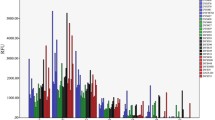Abstract
Validation studies were carried out using the commercially available PCR multiplex system genRESMPX-2. In addition to amelogenin, this system comprises the complete set of eight STR systems which are components of the German DNA database established in 1998 by the Federal Criminal Office of Germany (BKA). The minimum amount of template DNA which gave a complete DNA pattern ranged between 100 pg and 200 pg. Mixed samples could clearly be assigned from ratios between 1:5 (ACTBP2) and 1:20 (VWA, FGA). Experimental investigations with different forensic materials, environmental studies, reproducibility and precision data as well as practical casework analysis revealed that the genRESMPX-2 kit can be regarded as a sensitive, reliable and robust multiplex system even in the case of samples containing limited amounts or degraded DNA.



Similar content being viewed by others
References
Budowle B (1995) Technical working group on DNA analysis methods. Guidelines for a quality assurance program for DNA analysis. Crime Lab Digest 22:21–43
Budowle B, Sprecher CJ (2001) Concordance study on population database samples using PowerPlexTM 16 kit and AmpFlSTR Profiler Plus kit and AmpFlSTR Cofiler kit. J Forensic Sci 46:637–641
Budowle B, Lindsey JA, DeCou JA, Koons BW, Giusti AM, Comey CT (1995) Validation and population studies of the loci LDLR, GYPA, HBGG, D7S8, and Gc (PM loci), and HLA-DQ alpha using a multiplex amplification and typing procedure. J Forensic Sci 40:45–54
Budowle B, Moretti TR, Niezgoda SJ, Brown BL (1998) CODIS and PCR-based short tandem repeat loci: law enforcement tools. In: Proceedings of the Second European Symposium on Human Identification. Promega Corporation, Madison, WI, pp 73–88
Cotton EA, Allsop RF, Guest JL, Frazier RRE, Koumi P, Callow IP, Seager A, Sparkes RL (2000) Validation of the AmpFlSTR SGM Plus system for use in forensic casework. Forensic Sci Int 112:151–161
Finis CJ (2001) Megaplex analysis from a single amplification: validation of the PowerPlexR16 system. Profiles DNA 4:3–6
Frank WE, Llewellyn BE, Fish PA et al. (2001) Validation of the AmpFlSTRTM Profiler Plus PCR Amplification kit for use in forensic casework. J Forensic Sci 46:642–646
Frazier RRE, Millican ES, Watson SK et al. (1996) Validation of the Applied Biosystems PrismTM 377 automated sequencer for forensic short tandem repeat analysis. Electrophoresis 17:1550–1552
Kimpton C, Gill P, Walton A, Urquhart A, Millican ES, Adams M (1993) Automated DNA profiling employing multiplex amplification of short tandem repeat loci. PCR Methods Appl 3:13–22
LaFountain MJ, Schwartz MB, Svete PA, Walkinshaw MA, Buel E (2001) TWGDAM validation of the AmpFlSTR Profiler Plus and AmpFlSTR COfiler STR multiplex systems using capillary electrophoresis. J Forensic Sci 46:1191–1198
Lazaruk K, Wallin J, Holt C, Nguyen T, Walsh PS (2001) Sequence variation in humans and other primates at six short tandem repeat loci used in forensic identity testing. Forensic Sci Int 119:1–10
Lederer T, Seidl S, Graham B, Betz P (2000) A new pentaplex PCR system for forensic casework analysis. Int J Legal Med 114:87–92
Levedakou EN, Freeman DA, Budzynski MJ et al. (2002) Characterization and validation studies of PowerPlex 2.1, a nine-locus short tandem repeat (STR) multiplex system and penta D monoplex. J Forensic Sci 47:757–772
Lins AM, Sprecher CJ,Puers C, Schumm JW (1996) Multiplex sets for the amplification of polymorphic short tandem repeat loci—silver stain and fluorescence detection. Biotechniques 20:882–889
Miller SA, Dykes DD, Polesky HF (1988) A simple salting out procedure for extracting DNA from human nucleated cells. Nucleic Acids Res 16:1215
Moretti TR, Baumstark AL, Defenbaugh DA, Keys KM, Smerick JB, Budowle B (2001) Validation of short tandem repeats (STRs) for forensic usage: performance testing of fluorescent multiplex STR systems and analysis of authentic and simulated forensic samples. J Forensic Sci 46:647–660
Oldroyd NJ, Urquhart AJ, Kimpton CP, Millican ES, Watson SK, Downes T, Gill PD (1995) A highly discriminating octoplex short tandem repeat polymerase chain reaction system suitable for human individual identification. Electrophoresis 16:334–337
Rand S, Schürenkamp M, Brinkmann B (2002) The GEDNAP (German DNA profiling group) blind trial concept. Int J Legal Med 116:199–206
Sparkes R, Kimpton C, Watson S et al. (1996) The validation of a 7-locus multiplex STR test for use in forensic casework (I). Mixtures, ageing, degradation and species studies. Int J Legal Med 109:186–194
Urquhart A, Oldroyd NJ, Colin PK, Gill P (1995) Highly discriminating heptaplex short tandem repeat PCR system for forensic identification. Biotechniques 18:116–121
Wallin JM, Buoncristiani MR, Lazaruk KD, Fildes N, Holt CL, Walsh PS (1998) TWGDAM validation of the AmpFlSTR Blue PCR amplification kit for forensic casework analysis. J Forensic Sci 43:854–870
Walsh PS, Metzger DA, Higuchi R (1991) ChelexR 100 as a medium for simple extraction of DNA for PCR-based typing from forensic material. Biotechniques 10:506–513
Walsh PS, Erlich HA, Higuchi R (1992) Preferential PCR amplification of alleles: mechanisms and solutions. PCR Methods Appl 1:241–250
Walsh PS, Fildes NJ, Reynolds R (1996) Sequence analysis and characterization of stutter products at the tetranucleotide repeat locus vWA. Nucleic Acids Res 24:2807–2812
Acknowledgements
The authors wish to acknowledge Marianne Steevens and Waltraud Hargesheimer for helpful technical assistance.
Author information
Authors and Affiliations
Corresponding author
Additional information
A. Junge and T. Lederer contributed equally to the data presented
Rights and permissions
About this article
Cite this article
Junge, A., Lederer, T., Braunschweiger, G. et al. Validation of the multiplex kit genRESMPX-2 for forensic casework analysis. Int J Legal Med 117, 317–325 (2003). https://doi.org/10.1007/s00414-003-0385-4
Received:
Accepted:
Published:
Issue Date:
DOI: https://doi.org/10.1007/s00414-003-0385-4




